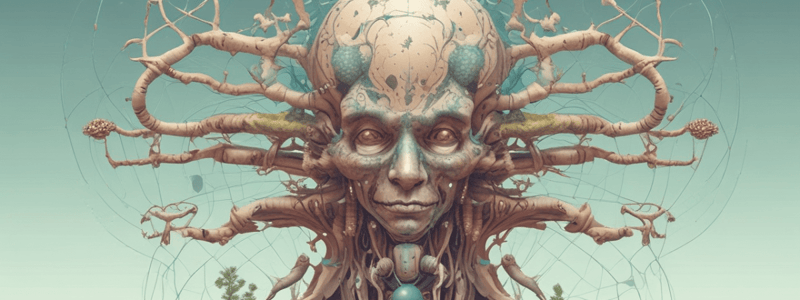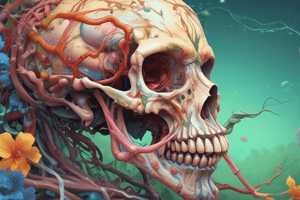Podcast
Questions and Answers
What is the primary focus of botany within the field of biology?
What is the primary focus of botany within the field of biology?
- The study of the genetic material and its functions
- The study of plants and their interactions with the environment (correct)
- The study of animals and their behaviors
- The study of microorganisms and their effects
Which cellular organelle is primarily responsible for generating energy for the cell?
Which cellular organelle is primarily responsible for generating energy for the cell?
- Lysosomes
- Ribosomes
- Mitochondria (correct)
- Endoplasmic reticulum
Which of the following mechanisms of evolution involves random changes in the gene pool?
Which of the following mechanisms of evolution involves random changes in the gene pool?
- Genetic drift (correct)
- Natural selection
- Mutation
- Gene flow
Flashcards are hidden until you start studying
Study Notes
Definition and Scope
- Biology is the scientific study of life and living organisms, including their structure, function, growth, evolution, distribution, and taxonomy.
- It explores the diversity of life forms, from the simplest bacteria to complex ecosystems.
Branches of Biology
- Botany: the study of plants and their interactions with the environment
- Zoology: the study of animals and their interactions with the environment
- Microbiology: the study of microorganisms, such as bacteria and viruses
- Ecology: the study of the relationships between organisms and their environment
- Evolutionary Biology: the study of the processes that have shaped the diversity of life on Earth
- Molecular Biology: the study of the structure, function, and interactions of biomolecules, such as DNA and proteins
Cell Biology
- Cell: the basic unit of life, consisting of a membrane-bound compartment with genetic material (DNA or RNA)
- Cellular organelles:
- Nucleus: contains genetic material
- Mitochondria: generates energy for the cell
- Endoplasmic reticulum: involved in protein synthesis and transport
- Ribosomes: site of protein synthesis
- Lysosomes: contains digestive enzymes
- Cellular processes:
- Photosynthesis: the process by which plants convert light energy into chemical energy
- Respiration: the process by which cells generate energy from glucose
Genetics
- Heredity: the passing of traits from parents to offspring
- DNA (deoxyribonucleic acid): the molecule that contains genetic information
- Genes: segments of DNA that code for specific traits
- Chromosomes: thread-like structures made up of DNA and proteins
- Inheritance patterns:
- Mendelian inheritance: follows the laws of segregation and independent assortment
- Polygenic inheritance: involves the interaction of multiple genes
Evolution
- Theory of evolution: explains the diversity of life on Earth through the process of natural selection
- Mechanisms of evolution:
- Mutation: changes in the DNA sequence
- Genetic drift: random changes in the gene pool
- Gene flow: the movement of genes between populations
- Natural selection: the selection of individuals with favorable traits
- Evidence for evolution:
- Fossil record: shows the history of life on Earth
- Comparative anatomy: reveals similarities and differences between species
- Molecular biology: confirms the relatedness of organisms through DNA and protein sequences
Definition and Scope
- Biology is the scientific discipline focused on life, investigating the structure, function, growth, evolution, distribution, and classification of living organisms.
- Encompasses a vast range of life forms, from unicellular organisms like bacteria to complex multicellular ecosystems.
Branches of Biology
- Botany: Investigates plant life, their biology, chemistry, and interactions with environments.
- Zoology: Examines animal species, their behaviors, and ecological roles.
- Microbiology: Studies microorganisms including bacteria, viruses, fungi, and protozoa.
- Ecology: Explores organism relationships and interactions with their environment, including ecosystems.
- Evolutionary Biology: Analyzes the mechanisms and processes driving the evolution of species over time.
- Molecular Biology: Focuses on the molecular basis of biological activity, involving biomolecules like DNA and proteins.
Cell Biology
- Cell: Fundamental unit of life, composed of a membrane-bound structure that contains genetic material.
- Cellular Organelles:
- Nucleus: Houses genetic information (DNA).
- Mitochondria: Produces adenosine triphosphate (ATP), the energy currency of the cell.
- Endoplasmic Reticulum: Facilitates protein synthesis and transportation; consists of rough (with ribosomes) and smooth (without ribosomes) variants.
- Ribosomes: Sites of protein assembly from amino acids.
- Lysosomes: Contain enzymes for the breakdown and recycling of cellular waste.
- Cellular Processes:
- Photosynthesis: Enables plants to convert sunlight into chemical energy, primarily in the form of glucose.
- Respiration: The metabolic process through which cells extract energy from glucose.
Genetics
- Heredity: Mechanism through which traits are transmitted from one generation to the next.
- DNA: Structurally double-helix, this nucleic acid encodes genetic information essential for life.
- Genes: Specific sequences of DNA that correspond to inherited traits.
- Chromosomes: Organized structures of DNA and proteins that contain numerous genes.
- Inheritance Patterns:
- Mendelian Inheritance: Describes how traits segregate and assort independently according to Gregor Mendel's laws.
- Polygenic Inheritance: Involves multiple genes contributing to a single trait, resulting in a continuum of phenotypes.
Evolution
- Theory of Evolution: Explains biological diversity via natural selection, where advantageous traits become more common in successive generations.
- Mechanisms of Evolution:
- Mutation: Random changes in DNA that may introduce new traits.
- Genetic Drift: Random fluctuations in allele frequencies, particularly in small populations.
- Gene Flow: Transfer of genetic material between separate populations through migration or interbreeding.
- Natural Selection: Favoring individuals with advantageous traits that enhance survival and reproduction.
- Evidence for Evolution:
- Fossil Record: Provides chronological evidence of organisms that existed and how they changed over time.
- Comparative Anatomy: Studies structural similarities and differences that reflect evolutionary relationships.
- Molecular Biology: Analyzes genetic sequences to demonstrate relatedness among different species.
Studying That Suits You
Use AI to generate personalized quizzes and flashcards to suit your learning preferences.




